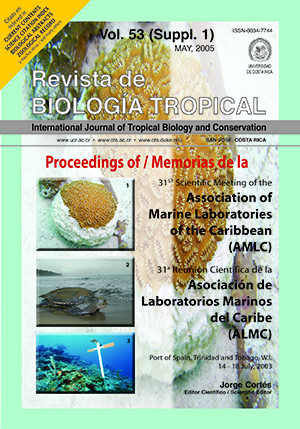Abstract
The Gulf of Paria receives heavy metal input from urban runoff, industrial and agricultural activity, sewage and domestic wastes: both from the west coast and from inland areas of Trinidad. Non-residual concentrations of nine metals, as well as total mercury concentrations, were used to determine spatial distributions of heavy metals in sediments in the Gulf of Paria. Surficial sediment samples were collected at 37 stations, which included the mouths of 11 major rivers that flow into the Gulf of Paria. Stations were sampled twice during the wet season (July 1998 and November/ December 1998) and twice during the dry season (March 1999 and April 1999). Sediments were analyzed for aluminium (Al), cadmium (Cd), chromium (Cr), copper (Cu), iron (Fe), lead (Pb), manganese (Mn), nickel (Ni), zinc (Zn) and mercury (Hg). Total Organic Carbon (TOC) and grain size analyses were also performed on the sediments. Principal component analysis showed that sediments from river mouths subject to greatest land use and anthropogenic input, were distinct from other sediments in the Gulf of Paria. This was due to higher Pb, Zn, Cu and Hg concentrations (3.53-73.30 μg g-1, 45.8-313.9 μg g-1, 8.43-39.71 μg g-1 and 0.03-0.10 μg g-1, respectively). Sediments further from the coast were also distinct due to their higher Al, Fe, Cr and Mn concentrations (1.37-3.16 mg g-1, 9.51-18.91 mg g-1, 17.22-28.41 μg g-1 and 323.6–1,564.2 μg g-1, respectively). Cd and Pb were higher in the wet season while Ni was higher in the dry season. Pb, Zn, Cu and Hg were correlated with each other and with TOC. Correlation was also observed between Al, Fe, Cr, Mn and Ni. Al, Fe, Cr and Mn were correlated with percentage clay in sediments. The results suggest that Pb, Zn, Cu and Hg are preferentially removed by organic matter, which settles at the river-mouths, while Al, Fe, Cr, Mn, and Ni become associated with clay minerals and are transported away from the coast.References
Buchanan, J. & K. Kain. 1971. The determination of organic matter in sediments, p. 49-50. In W. Holme & A. McIntyre (eds.). Methods for the Study of Marine Benthos. Blackwell Scientific, Oxford.
Chen, M., L. Ma & W. Harris. 1999. Baseline concentrations of 15 trace elements in Florida surface soils. J. Environm. Qual. 28: 1173-1181.
Doherty, G., G. Brunskill & M. Ridd. 2000. Natural and enhanced concentrations of trace metals in sediments of Cleveland Bay, Great Barrier Reef Lagoon, Australia. Mar. Poll. Bull. 41: 337-344.
Environmental Canada. 1979. Analytical Methods Manual, Part 4. IWD (Inland Waters Directorate). Water Quality Branch, Ottawa, Canada. 34 p.
Fergusson, J. (ed.). 1990. The Heavy Elements: Chemistry, Environmental Impact and Health Effects. Pergamon, Oxford. 614 p.
Folk, R. 1974. Petrology of Sedimentary Rocks. Hemphill, Texas. 182 p.
Forstner, U. & G. Wittmann. 1979. Metal Pollution in the Aquatic Environment. Springer, Berlin. 486 p.
Oliver, B. 1973. Heavy metal levels of Ottawa and Rideau River sediments. Environ. Sci. Tech. 7: 135.
Zitko, V. 1994. Principal component analysis in the evaluation of environmental data. Mar. Poll. Bull. 28: 218- 222.
CCME. 1999. Canadian sediment quality guidelines for the protection of aquatic life. CCME (Canadian Council of Ministers of the Environment). (Downloaded: December 7, 1999, www.ec.gc.ca/ceqg-rcqe).
##plugins.facebook.comentarios##

This work is licensed under a Creative Commons Attribution 4.0 International License.
Copyright (c) 2005 Revista de Biología Tropical






